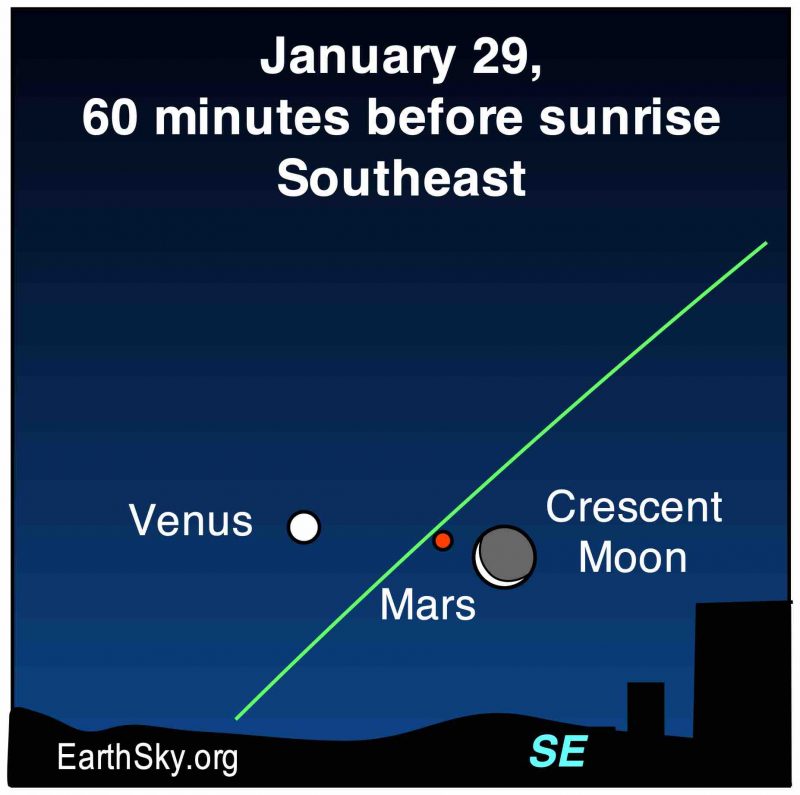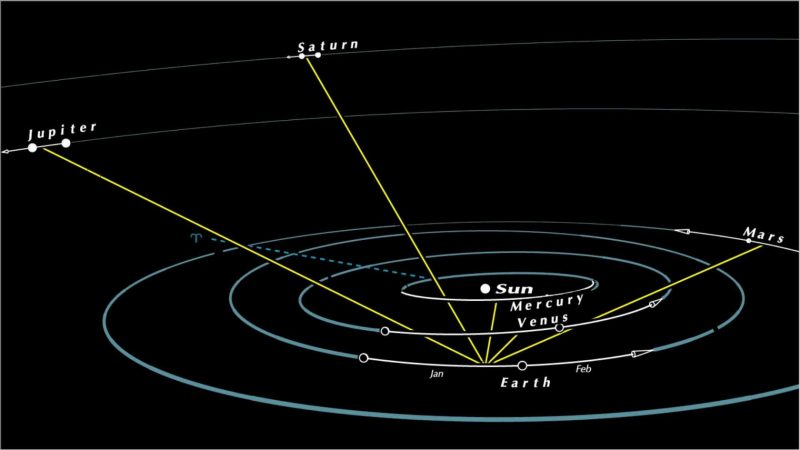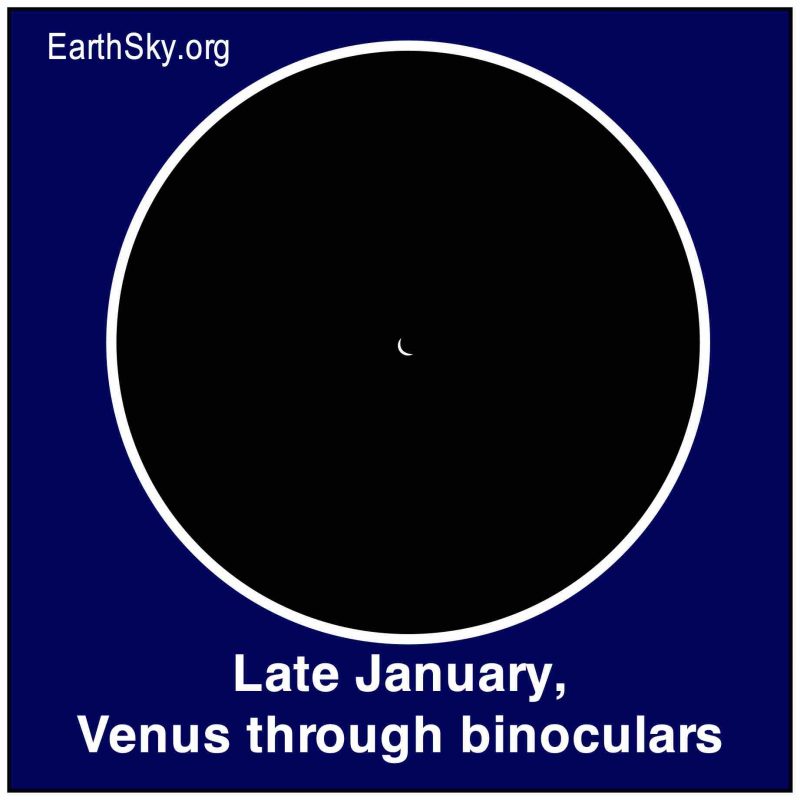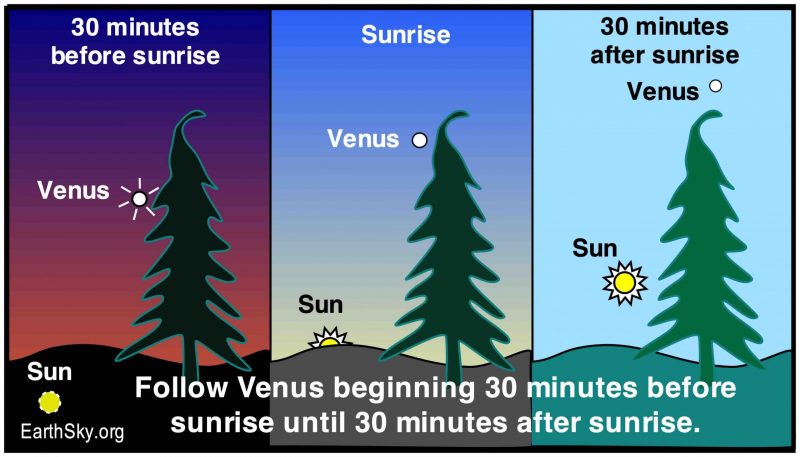
Moon with Mars and Venus
On the morning of January 29, 2022, the old moon – a waning crescent – will join Venus and Mars. Brilliant Venus, far-dimmer Mars and the glowing crescent moon will form an intriguing and picturesque celestial line-up, low in the east before sunrise. So don’t forget to take a photo and submit it to us! Look for the slender crescent glowing with earthshine in the sunrise direction (east), shortly before the sun comes up. Venus will be bright and unmistakable near the moon. Dim Mars will be harder to spot, but also near the moon. Notice that Mars is glowing dimly reddish.
Here at the end of January 2022, Venus is especially bright! It has passed its inferior conjunction on January 8-9, 2022. That’s when Venus – in its smaller, faster orbit – swept between the Earth and sun. Now Venus is heading toward another greatest brilliancy on February 9, 2022.
The 2022 lunar calendars are here. Order yours before they’re gone!
Why is Venus so bright?
Venus orbits one step inward from Earth. It passed between us and the sun earlier this month. So now the lighted face of Venus (its day side) is still turned mostly away from us now. That means that, from our earthly perspective, Venus appears as a crescent world. But that lighted crescent is relatively large in our sky, because Venus is still relatively nearby. Voilà. Greatest brilliancy.

See Venus as a crescent
Aim a pair of well-focused binoculars toward Venus. In January 2022, we on Earth see Venus as a tiny crescent. That’s because it’s nearby and its lighted portion of “day” side is facing mostly away from us.

See Venus in daytime
Venus is now bright enough that you might be able to see in the daytime. Check this out for yourself by spotting Venus 30 minutes before sunrise. Follow it in the brightening sky by situating yourself so that it appears placed just above a distant reference object such as a utility pole or a tree. Keep it placed above the reference object as the minutes pass. You’ll still be able to see it after the sun rises. You can keep following it for the rest of the morning.

Bottom line: See the moon with Mars and Venus on the morning of January 29, when the trio form a line near the southeastern horizon before sunrise.
Read more about how to see the planets.
The post Moon, Mars and Venus, morning of January 29 first appeared on EarthSky.
from EarthSky https://ift.tt/3fRWwgh

Moon with Mars and Venus
On the morning of January 29, 2022, the old moon – a waning crescent – will join Venus and Mars. Brilliant Venus, far-dimmer Mars and the glowing crescent moon will form an intriguing and picturesque celestial line-up, low in the east before sunrise. So don’t forget to take a photo and submit it to us! Look for the slender crescent glowing with earthshine in the sunrise direction (east), shortly before the sun comes up. Venus will be bright and unmistakable near the moon. Dim Mars will be harder to spot, but also near the moon. Notice that Mars is glowing dimly reddish.
Here at the end of January 2022, Venus is especially bright! It has passed its inferior conjunction on January 8-9, 2022. That’s when Venus – in its smaller, faster orbit – swept between the Earth and sun. Now Venus is heading toward another greatest brilliancy on February 9, 2022.
The 2022 lunar calendars are here. Order yours before they’re gone!
Why is Venus so bright?
Venus orbits one step inward from Earth. It passed between us and the sun earlier this month. So now the lighted face of Venus (its day side) is still turned mostly away from us now. That means that, from our earthly perspective, Venus appears as a crescent world. But that lighted crescent is relatively large in our sky, because Venus is still relatively nearby. Voilà. Greatest brilliancy.

See Venus as a crescent
Aim a pair of well-focused binoculars toward Venus. In January 2022, we on Earth see Venus as a tiny crescent. That’s because it’s nearby and its lighted portion of “day” side is facing mostly away from us.

See Venus in daytime
Venus is now bright enough that you might be able to see in the daytime. Check this out for yourself by spotting Venus 30 minutes before sunrise. Follow it in the brightening sky by situating yourself so that it appears placed just above a distant reference object such as a utility pole or a tree. Keep it placed above the reference object as the minutes pass. You’ll still be able to see it after the sun rises. You can keep following it for the rest of the morning.

Bottom line: See the moon with Mars and Venus on the morning of January 29, when the trio form a line near the southeastern horizon before sunrise.
Read more about how to see the planets.
The post Moon, Mars and Venus, morning of January 29 first appeared on EarthSky.
from EarthSky https://ift.tt/3fRWwgh

Aucun commentaire:
Enregistrer un commentaire